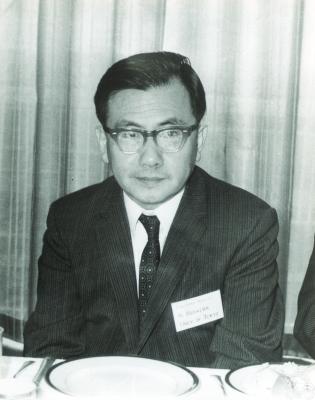- Kunihiko Kodaira
Infobox Scientist
name =Kunihiko Kodaira
box_width =
image_width =
caption =
birth_date =Birth date|1915|03|16
birth_place =Tokyo ,Japan
death_date =Death date and age|1997|07|26|1915|03|16
death_place =Kōfu,Japan
residence =
citizenship =JPN
nationality =
ethnicity =
field =Mathematics
work_institutions =Institute for Advanced Study
alma_mater =University of Tokyo
doctoral_advisor =Shokichi Iyanaga
doctoral_students =
known_for =Algebraic geometry ,complex manifold s
author_abbrev_bot =
author_abbrev_zoo =
influences =
influenced =
prizes =Fields Medal (1954)Wolf Prize (1984/5)
footnotes =nihongo|Kunihiko Kodaira|小平 邦彦|Kodaira Kunihiko|
16 March ,1915 –26 July ,1997 was aJapan esemathematician known for distinguished work inalgebraic geometry and the theory ofcomplex manifold s, and as the founder of the Japanese school of algebraic geometers. He was awarded aFields Medal in 1954, being the first Japanese to receive this honour.Early years
He was born in
Tokyo . He graduated from theUniversity of Tokyo in 1938 with a degree in mathematics and also graduated from the physics department at theUniversity of Tokyo in 1941. During the war years he worked in isolation, but was able to masterHodge theory as it then stood. He obtained hisPh.D. degree from theUniversity of Tokyo in 1949, with a thesis entitled "Harmonic fields in Riemannian manifolds". He was involved in cryptographic work from about 1944, at a time of great personal difficulty, while holding an academic post in Tokyo.Institute for Advanced Study
In 1949 he travelled to the
Institute for Advanced Study inPrinceton, New Jersey at the invitation ofHermann Weyl . At this time the foundations of Hodge theory were being brought in line with contemporary technique in operator theory. Kodaira rapidly became involved in exploiting the tools it opened up in algebraic geometry, addingsheaf theory as it became available. This work was particularly influential, for example onHirzebruch .In a second research phase, Kodaira wrote a long series of papers in collaboration with
D. C. Spencer , founding thedeformation theory of complex structures on manifolds. This gave the possibility of constructions ofmoduli space s, since in general such structures depend continuously on parameters. It also identified the sheaf cohomology groups, for the sheaf associated with theholomorphic tangent bundle , that carried the basic data about the dimension of the moduli space, and obstructions to deformations. This theory is still foundational, and also had an influence on the (technically very different)scheme theory ofGrothendieck . Spencer then continued this work, applying the techniques to structures other than complex ones, such asG-structure s.In a third major part of his work, Kodaira worked again from around 1960 through the
classification of algebraic surfaces , frombirational geometry , from the point of view of complex manifold theory. This resulted in a typology of seven kinds of two-dimensional compact complex manifolds, recovering the five algebraic types known classically; the other two being non-algebraic. He provided also detailed studies ofelliptic fibration s of surfaces over a curve, or in other languageelliptic curve s overfunction field s, a theory whose arithmetic analogue proved important soon afterwards. This work also included a characterisation ofK3 surface s as deformations ofquartic surface s in "P"4, and the theorem that they form a singlediffeomorphism class. Again, this work has proved foundational. (The K3 surfaces were named after Kummer, Kähler, and Kodaira).Later years
Kodaira left the Institute for Advanced Study in 1961, and briefly served as chair at the
Johns Hopkins University andStanford University In 1967, returned to theUniversity of Tokyo . He was awarded aWolf Prize in 1984/5. He died inKofu on26 July ,1997 .ee also
*
Spectral theory of ordinary differential equations
*Kodaira vanishing theorem
*Kodaira-Spencer mapping
*Kodaira dimension
*Kodaira embedding theorem External links
*MathGenealogy |id=20660
*MacTutor Biography|id=KodairaPersondata
NAME= Kodaira, Kunihiko
ALTERNATIVE NAMES=
SHORT DESCRIPTION=Mathematics
DATE OF BIRTH=March 16 ,1915
PLACE OF BIRTH=Tokyo ,Japan
DATE OF DEATH=July 26 ,1997
PLACE OF DEATH=Kōfu, Yamanashi ,Japan
Wikimedia Foundation. 2010.
